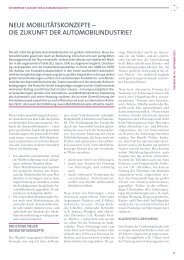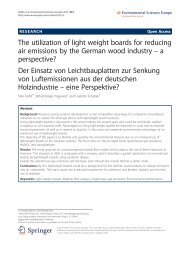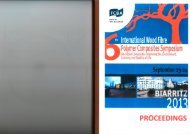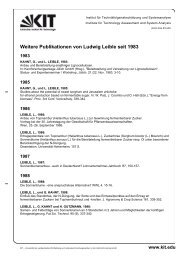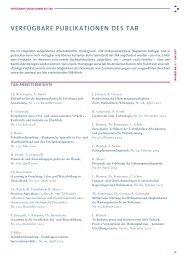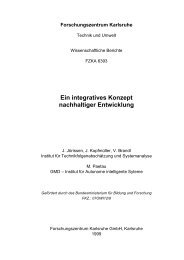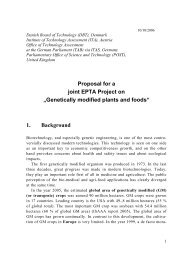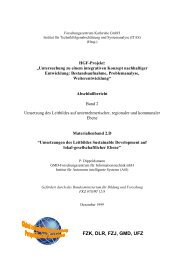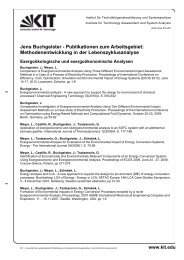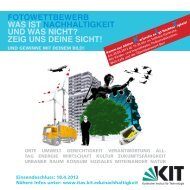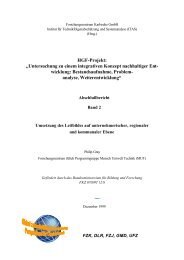Results: RFID and Identity Management in everyday life - ITAS
Results: RFID and Identity Management in everyday life - ITAS
Results: RFID and Identity Management in everyday life - ITAS
Create successful ePaper yourself
Turn your PDF publications into a flip-book with our unique Google optimized e-Paper software.
Aim <strong>and</strong> methodology<br />
This research aims to provide <strong>in</strong>sight <strong>in</strong>to how users <strong>and</strong> owners/ma<strong>in</strong>ta<strong>in</strong>ers of different<br />
environments manage identity. <strong>Identity</strong> <strong>Management</strong> is understood as how a person, <strong>in</strong>teract<strong>in</strong>g<br />
with an <strong>in</strong>formation system, def<strong>in</strong>es what is known <strong>and</strong> not known about him/her to the system <strong>and</strong><br />
how this relates to how this is def<strong>in</strong>ed by the owner of the system.<br />
Research questions<br />
In order to reach this aim, the follow<strong>in</strong>g research questions are formulated:<br />
• In what k<strong>in</strong>ds of sett<strong>in</strong>gs are <strong>RFID</strong> systems used to identify people?<br />
• What purposes do the <strong>RFID</strong> systems serve?<br />
• What k<strong>in</strong>d of <strong>in</strong>formation is stored on the chip <strong>and</strong> database of the <strong>RFID</strong> system?<br />
• How do users <strong>and</strong> owners of the system, consciously or unconsciously, <strong>in</strong>fluence what k<strong>in</strong>d of<br />
personal <strong>in</strong>formation is known?<br />
• What are the tradeoffs of provid<strong>in</strong>g more or less personal <strong>in</strong>formation?<br />
• What choices are available to the users <strong>and</strong> owners of the <strong>RFID</strong>-systems <strong>in</strong> <strong>in</strong>teract<strong>in</strong>g with the<br />
system?<br />
Methodology<br />
Be<strong>in</strong>g still relatively <strong>in</strong>visible <strong>in</strong> the public debate, <strong>RFID</strong> is difficult to <strong>in</strong>vestigate through quantitative<br />
methods. A survey by Cap Gem<strong>in</strong>i for example ‘<strong>RFID</strong> <strong>and</strong> Consumers’ (2005), showed very few<br />
European citizens even know what <strong>RFID</strong> is, let alone have formed an op<strong>in</strong>ion on it. Only 20% had<br />
ever heard of <strong>RFID</strong> <strong>and</strong> the respondents who could state an op<strong>in</strong>ion needed much additional technical<br />
explanation. As the awareness is still low <strong>and</strong> the net sample of actual experience will be too small,<br />
surveys can merely scratch the surface of how users actually deal with smart environments. The case<br />
study method therefore applies more to this issue, as it can both provide a broad view of the situation<br />
as well as a more <strong>in</strong>-depth analysis of what actually happens once people use <strong>RFID</strong> systems.<br />
A case study is def<strong>in</strong>ed as a qualitative description <strong>and</strong> analysis of an event, specified <strong>in</strong> time <strong>and</strong><br />
place, with specified actors (organisations or <strong>in</strong>dividuals). In theory, a s<strong>in</strong>gle case study can be the<br />
base of empirically based claims. In order to analyse the use of <strong>RFID</strong> <strong>in</strong> different contexts, we need a<br />
broader empirical base by perform<strong>in</strong>g a number of case studies. To strike a balance between both<br />
empirical depth <strong>and</strong> broadness, we use a funnel approach, which starts with a broad variety of lessdetailed<br />
case studies to survey the area <strong>and</strong> funnel down to a small number of cases to be <strong>in</strong>vestigated<br />
more thoroughly. In our research, we dist<strong>in</strong>guished four levels:<br />
Level 0 case: Description of function of a specific <strong>RFID</strong> application (e.g. access, payments), where<br />
<strong>and</strong> when it is used by who <strong>in</strong> what k<strong>in</strong>d of sett<strong>in</strong>g (e.g. public transport, leisure).<br />
Level 1 case: Level 0 + desk research (reports, websites, newspapers, etc.) to describe users <strong>and</strong><br />
ma<strong>in</strong>ta<strong>in</strong>ers <strong>and</strong> possible <strong>Identity</strong> <strong>Management</strong> issues.<br />
Level 2 case: Level 1 + additional <strong>in</strong>quiry through e-mail or phone contact.<br />
Level 3 case: Level 2 + site visit to observe users <strong>and</strong> hold <strong>in</strong>terviews with people <strong>in</strong>volved.<br />
7



